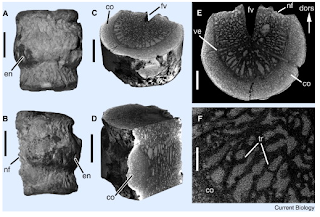 |
I know what you're thinking: of course they did - what organism out there isn't parasitized by viruses and their ilk? But where's the evidence? In science you can't just pluck ideas out of the air like this - no matter how obvious they are - and say they are true; maybe dinosaurs had a fantastic immune system and were able to thwart any potential viral invaders. What I'm saying is that we just don't know, but a paper published last month in Current Biology suggests otherwise: documenting the discovery that some dinosaur (see above) fossils bare lesions in their bones that are suggestive of viral infection.
Paget disease of bone in a Jurassic dinosaur
 |
| Paget's disease in humans |
How can we know if a dinosaur was ever infected by viruses? Well, if you think you've been infected (maybe you've got a cough, dry throat and a fever) you'll go to the doctor, and maybe if he's particularly worried he may carry out some sophisticated diagnostic tests: try growing the virus, isolate viral nucleic acids or look at your antibodies you've produced. All of which would indicate yes you're infected and would even tell us what you were infected with. Influenza A, rhinovirus C or even coronavirus 229E, for example. But how does this work for something that has been dead for millions of years? Especially considering they are: a) fossilized, b) no tissues, including virus particles are around and c) even proteins and DNA are gone.
So check out how they did it:
Paget disease of bone — initially described by Sir James Paget in 1876 — is a benign bone disorder well known in human pathology. It leads to the enlargement and deformity of bones due to a combination of abnormal bone resorption and abundant new bone formation [1,2,3]. There is strong evidence that viruses are involved in the disease, coupled with a probable genetic component [3,4]. Paget disease in humans most frequently involves the skull, the spine and parts of the pelvis [1,2,3]. There is only limited evidence on Paget disease in other extant mammals, such as orangutans and lemurs [5]. Paget disease has also been described in human bones dating back to the Neolithic [6]. Here, we report Paget disease in a vertebra of the Jurassic dinosaur Dysalotosaurus lettowvorbecki, representing the oldest indirect evidence of viruses in the fossil record.
Using a CT scan (see opposite) to study a dinosaur fossil vertebrae, the group uncovered the classic signs of Paget's disease, (although I am no pathologist and cannot comment on whether it's real) where - for an unknown reason - structural changes occur in the bones resulting in redistribution of bone and increase in the amount of blood vessels within the bone marrow. It can be very painful and depending which bones it affects, can leave the sufferer with a multitude of problems, but luckily the prognosis is particular good if caught early. The causes of this disease have not been fully uncovered, and there appears to be evidence of both genetic (sequestesome for example) and environmental (viral) components.
It is the paramyxoviruses - measles in particular - that are associated with Paget's disease - with some studies showing that certain bone cells express large amounts of measles nucleocapsid protein. A recent study in Cell Metabolism, explores - in a mouse model - the role that this protein has in conjunction with a previously identified genetic change and identifies that at least in some patients, it's expression in bone results in a Paget-like disease. Other studies show that in some cases, detection of measles in Paget bone cells may be down to contamination.
 |
| Measles nucleocapsid protein in Paget's disease of humans? |
Despite these problems in whether or not there is a viral component to Paget's disease in humans, this paper uses it as indirect evidence to say that dinosaurs were in fact infected with a paramyxovirus-like parasite. There is also some work detailing a Paget's-like disease in reptiles, like the Burmese Python. Interestingly, this paper isn't the first evidence of prehistoric viruses: groups had observed viral-like structures inside amber-trapped insects and previous work had even detailed non-viral dinosaur parasites.
But, as predicted when dealing with indirect evidence of this sort (we cannot grow ancient viruses, we haven't uncovered viral genomes and there is little chance of detecting a dinosaur antibody response) this all must be taken with a large pinch of salt. Even discounting a viral cause of this dinosaur's disease, it certainly shines some light on the evolution of Paget's disease across different species.
Dysaolotosaurus picture by Kira and Bod.
For other measles posts see here.


















No comments:
Post a Comment
Markup Key:
- <b>bold</b> = bold
- <i>italic</i> = italic
- <a href="http://www.fieldofscience.com/">FoS</a> = FoS